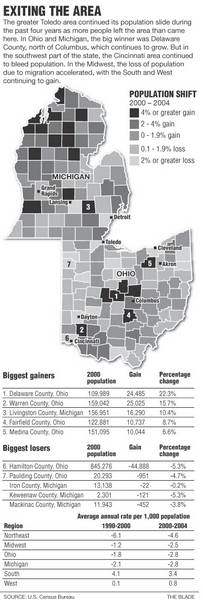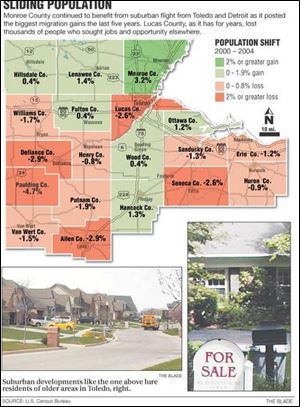
Lucas County population drops by 11,635 as Monroe County gains
4/20/2006

Where jobs go, people follow. And Census statistics released today indicate Lucas County - and Ohio as a whole - is a perfect example of that axiom, experts say.
Census "migration" totals from April, 2000, to July, 2004 - meaning population changes from people moving into or out of an area, while ignoring shifts from births or deaths - showed a continuation of Lucas County's population decline: a loss of 11,635 people, or 2.6 percent of the population.
The big winner for the area is Monroe County - with a 3.4 percent increase in Census population from migration. Those with eyes pointed north note boom times in the areas around Dundee, Mich., and Bedford Township.
David Gedeon, manager of growth strategies for the Toledo Metropolitan Area Council of Governments, said the reason is simple.
"The job market hasn't exactly favored Lucas County," he said. "Nothing dramatic has happened in Lucas County to get that trend to change."
Mark Cruse, a Realtor with the Danberry Co. in Toledo for 22 years, noted that the relocation business - people moved here from another city by their employer - "is almost nonexistent" in Toledo.

And with the post-millennium economic decline, he's also noted an increase in foreclosures.
Sometimes you re very shocked when you go to show a home and you see a bank-owned property in an area where, five to 10 years ago, you d say, This doesn t happen, Mr. Cruse said.
Other counties in the area that suffered a population decline above 2 percent from 2000 to 2004 were Paulding, with a 4.7 percent decrease; Allen, 2.9; Defiance, 2.9 percent; and Seneca, 2.6 percent.
On a larger scale, Lucas County s loss to migration is actually less than Ohio s 2.8 percent, and a bit more than the 2.5 percent average for the Midwest.
William Frey, a demographer for the Brookings Institution, a Washington-based think tank, blamed the Midwest trend on two things: economy and climate.
Yes, there s the continued legacy of job losses from heavy industrial downsizing over the last 20 years and recent automobile industry losses, but Mr. Frey added: Let s face it, it s cold.
Still, most experts focus on the former.
What we re seeing is an ongoing process of a conversion from labor to technology, said Mark Salling, a researcher at Cleveland State University s Urban College in Cleveland.
While Ohio s manufacturing base has lost jobs to automation as companies turn to technology at the expense of people, the state and neighboring Michigan to some degree have remained in an economic downtown long after the rest of the nation has pulled out of it, economists have said.
Mr. Frey said Toledo does have one thing going for it: the Glass City is not losing people as quickly as many of the nation s top metropolitan areas. New York City, Los Angeles , and Chicago showed population decreases from migration of 11.4, 9.3, and 6.8 percent, respectively, from 2000 to 2004. That s much worse than the Toledo metropolitan region s 2.6 percent decline for that period.
Housing prices are getting so much higher on the coasts, they re getting out of bounds for some people, he said.
While the success of the Cabela s outdoors store in the Dundee area is apparent to anyone traveling U.S. 23 in Michigan, Bedford Township s growth is a story of older buyers wanting big properties with a quiet, rustic appeal, experts say.
You re primarily dealing with people wanting lifestyle changes: bigger acreage, good schools, and amenities, Mr. Cruse said. A place to put horses, run all-terrain vehicles, put in a swimming pool.
But it s more than that, local officials say. Jon White, superintendent of the Bedford School District, noted his district s overall enrollment is actually declining, though his high-school enrollment is up. He s also noticed the large amount of mature home buyers and retirement villages that are cropping up in the area.
Dennis Steinman, a Bedford Township trustee for the past 26 years, agreed that the majority of newcomers are people 55-plus on their second or third home.
Besides safer streets and solitude, he cited the area s lack of an income tax, and cheaper property taxes and utility rates compared to most other Toledo suburbs.
One figure in the latest Census report that surprised many experts contacted was for Wood County.
Despite a housing boom in the Perrysburg area and some other communities in the northern end, there was only a .4 percent increase from migration between 2000 and 2004.
Mr. Gedeon predicted a greater increase in the next Census release, noting development there has occurred mostly in the last two years.
Blade Staff Writer Mike Wilkinson contributed to this report and analyzed the Census migration data for northwest Ohio and southeast Michigan.
Contact Tad Vezner at:tvezner@theblade.comor 419-724-6050.